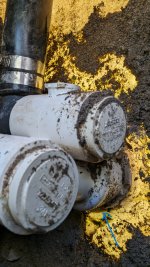Hi,
I thought it best to bin my other thread on the stair jets because it was far too long (likely why it didn't get a response - sorry!) with the back and forth on my findings and focus more specifically on current status and where I'm needing advice.
When I removed my winter plug on my stair jet, it also turned the housing it was screwed into, which caused a noticeable leak underground at the stairs. I tightened it by hand, but there's still a very minor leak (see the blue arrow in my first picture for where), especially when I use my finger to move the silicone (if that's what it is) around. See my second picture to see where I mean. Any thoughts on how to fix that, and also stop it happening in future? I'm not sure where to grip on the inside to tighten more, or if I need to somehow take it apart (is there room to do so?), add lubricant, or add more silicone, etc.?
On my third photo, you can see I had a fairly major leak where the black pipe comes from the stair jet and up to the vent (where you can allow more air in) when my winter plug was still in, even on very low pressure. When I removed the winter plug this stopped completely, even on high pressure. I'm guessing water just doesn't get up here under normal circumstances. Do I just ignore? Or try tighten the metal coupling?
If you want more photos, you can find them at: Stair Jet Leak - Google Drive
Thanks!
Graham.
I thought it best to bin my other thread on the stair jets because it was far too long (likely why it didn't get a response - sorry!) with the back and forth on my findings and focus more specifically on current status and where I'm needing advice.
When I removed my winter plug on my stair jet, it also turned the housing it was screwed into, which caused a noticeable leak underground at the stairs. I tightened it by hand, but there's still a very minor leak (see the blue arrow in my first picture for where), especially when I use my finger to move the silicone (if that's what it is) around. See my second picture to see where I mean. Any thoughts on how to fix that, and also stop it happening in future? I'm not sure where to grip on the inside to tighten more, or if I need to somehow take it apart (is there room to do so?), add lubricant, or add more silicone, etc.?
On my third photo, you can see I had a fairly major leak where the black pipe comes from the stair jet and up to the vent (where you can allow more air in) when my winter plug was still in, even on very low pressure. When I removed the winter plug this stopped completely, even on high pressure. I'm guessing water just doesn't get up here under normal circumstances. Do I just ignore? Or try tighten the metal coupling?
If you want more photos, you can find them at: Stair Jet Leak - Google Drive
Thanks!
Graham.










